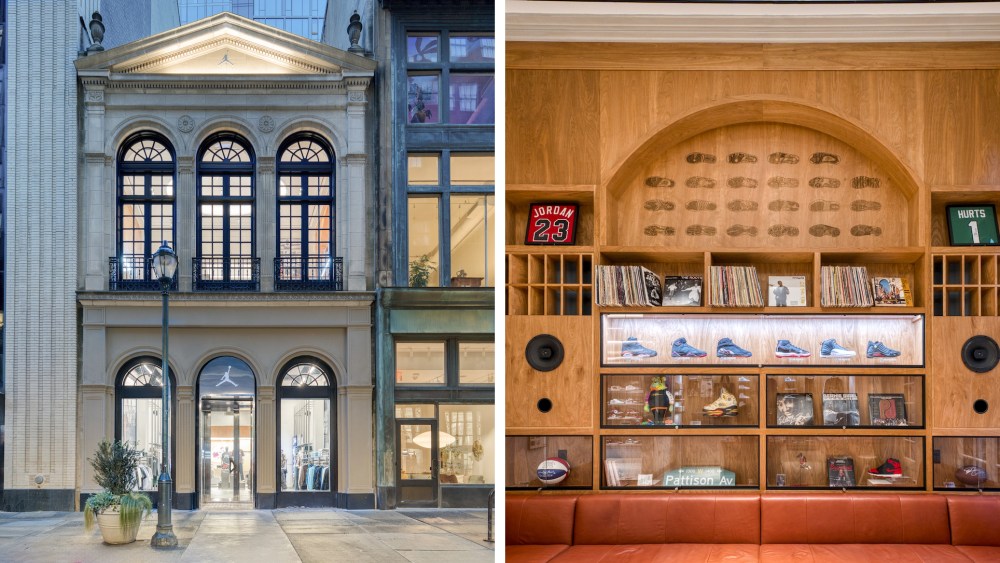
It’s 8 p.m. on a Tuesday night at Al Baretto San Marco, a trattoria modeled after a luxury yacht. The lights are dim and jazzy music swirls the intimate crowd. The bartender, who goes by Mr. Jose and is known around Milan for his ebullient personality and bushy beard, serves up his signature aperitif cocktail “Il Solito.” Adorned with a mini glacial ice block, it’s been shaken and cooled just right.
When the Linguina Monograno all’Astice arrives, there are oohs and aahs as a waiter tosses the pasta in front of guests and finishes with a sprinkling of zest from a cedro, a large Italian citrus. Across town, a waiter in a crisp white jacket at Osteria Serafina is tossing bigoli pasta in a giant pecorino wheel, old style, eliciting the same reaction. The international jetset at Serafina are sharing small dishes of puntarelle salad and cute “pierini sandwiches” made of beef diaphragm and a spicy sauce.
The scenes at these restaurants may appear like a snapshot of Rome during La Dolce Vita rather than modern day Milan, where understated chic and a slice of northern Italian chill is on the menu du jour.

Bartender, Mr. Jose at Al Baretto.
Courtesy of La Gioia
When its founder Redi Shijaku, who had formerly worked in the telecommunications and real estate sectors, started his first restaurant La Gioia in 2019, the timing was just right. Since then, he’s grown his business without the help of an outside investor, to five locations, a staff of 200 and 20 million euros in revenue. He projects 25 million euros in revenue by the end of 2025.
On a mission to define the “new Italian classic” with simple old school recipes with a unique edge, the La Gioia locations have quickly become known for their welcoming atmosphere, endeared by the fashion and design set, perfect for convivial dinners, where plates are shared and cocktails are served throughout, unbeholden to traditional Italian norms.

Serafina
Courtesy of La Gioia
Casting director Margit Cesana is a regular at Osteria Serafina, where she often brings friends and colleagues visiting from out of town. “It’s been our weekly go-to ever since it opened. It’s definitely a gem of the area. It’s honestly one of the best spots in Milan. The food is classic with a fun twist, the vibe is both cozy and stylish, and the staff is always super friendly,” Cesana says.
Just a year before Shijaku opened his first location, the city of Milan launched a plan to offer enticing tax incentives to lure international tax haven seekers, a number that rose to 1,495 from 263 in its first year, 2018. The tax break consists of a flat tax of 200,000 per year covering all foreign incomes. The flow of fresh residents has been a boost for businesses like La Gioia, but has had an inflationary impact — from rents to the price of a dish of pasta.
Fashion designer Tina Lutz Morris is one of those individuals attracted to Milan after the COVID-19 pandemic. After living in New York for 24 years and a short stint in Berlin, Lutz Morris found Milan to be a well-needed escape, with its mildly slower pace and charming locales, compared to the fast pace of other fashion capitals. Al Baretto is one of those local havens that offers everything she looks for in a restaurant — including bad lighting, she quips ironically.
“It ticks all the boxes: atmosphere, food, service and perfect lighting. I could come back over and over for the blackened seabass,” she enthuses, after an intimate networking dinner that included fashion media. In addition to her own brand Lutz Morris, the designer co-leads the global design and creative direction for German accessories brand MCM.

The staff at Al Baretto San Marco.
Courtesy of La Gioia
The secret sauce is Shijaku’s vision, which conjures the sort of Italy foreigners dream of — in terms of elegance, decor and inviting charm. “I’ve always been passionate about how Italy was represented in films, even in American films, where there was this portrayal of Italy as La Dolce Vita. But also the depiction of an Italian village,” the restauranteur muses, noting that his restaurants could be placed in a big metropolis like Milan or getaway destinations like Capri, Taormina in Sicily or Portofino. “These are luxurious spots that nonetheless remain very authentic to Italian villages, right? This desire, this dream that I had in my mind…we were able to bring it to life through a very carefully built concept. We developed La Gioia based on this idea of atmosphere.”
Shijaku has a talent for attracting personnel, too; memorable characters that keep people coming back. At the new Sant’Ambrogio location, opening Oct. 28, the front-of-house team is composed of individuals with strong charisma and stage presence, such as a new manager, Marco Sacco and former La Scala dancer Endi Bahaj and wine expert Telemaco Calandrino.
Al Baretto Sant’Ambrogio is in the heart of the fashionable Via Tortona area, on Via Privata Bobbio 1, situated adjacent to Langosteria Bistro, another successful Milanese concept contributing to the city’s reputation as a culinary capital. Langosteria is backed by Moncler chairman and chief executive officer Remo Ruffini’s investment vehicle Archive and helmed by his son Pietro Ruffini.
The new restaurant will build upon the legacy of the first Al Baretto San Marco, known for its exclusively seafood menu, understated charm and quiet luxury. With this second location, the format will evolve even further: Sant’Ambrogio will offer a broader and more expressive culinary experience, ranging from handmade pasta and refined seafood dishes to high-quality Italian meats — all served in a larger and more dynamic space with a unique energy and rhythm.
At the new location, the central cocktail bar will again evoke the deck of a luxury yacht and will serve as the core of the experience. A second, more secluded bar will complement the private dining area, while the sound and lighting design will adapt to the rhythm of the evening.

Redi Shijaku
Courtesy of La Gioia
For Shijaku, an Italian of Albanian origins who grew up in the agricultural rich countryside outside of Vicenza, defining the new Italian classic has as much to do with producing high-quality food with the best products as much as it does with encouraging his clients to simply have a good time.
“The bar, which is always at the center of our dining room, adds to this movement: someone may grab a drink while another person is eating. It creates a rhythm that is very different from what you’d normally find in an Italian restaurant, which is typically more static and doesn’t have this kind of dynamic rhythm,” he says.
Looking ahead, Shijaku said he’s building a business that can compete with these “billionaire-backed” enterprises around town. “I’ve received offers but I’ve said no to all of them. I am concentrated on building this business.”
The night at Al Baretto ends with a flourishing of sorbet, with a waiter churning the white mound in an iced silver bowl. As the perfectly iced cream hits the palate, one realizes that such creamy perfection can’t be found anywhere else.
#Gioia #Redefining #Italian #Dining #Milan






